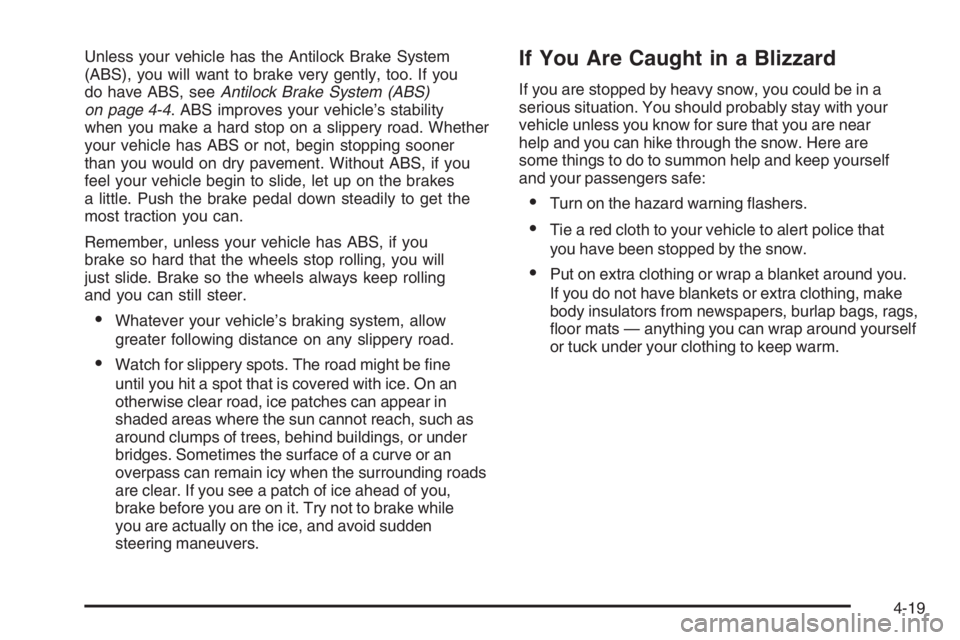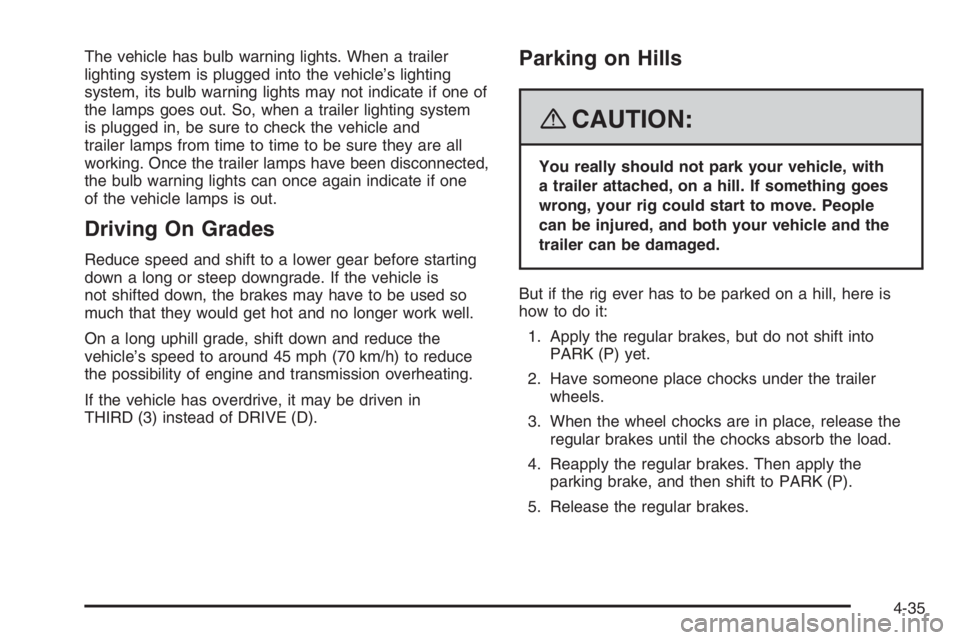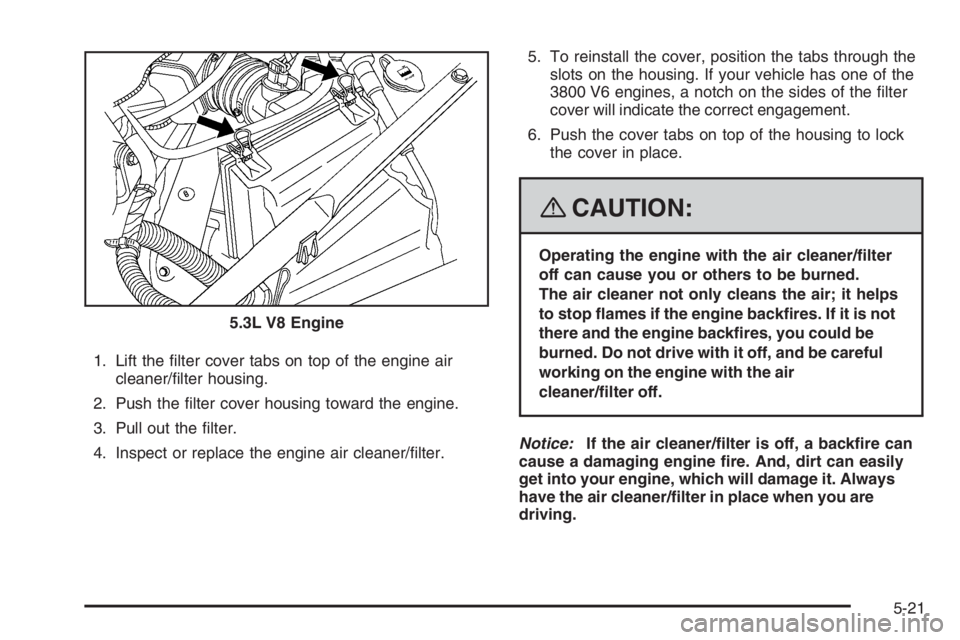2008 PONTIAC GRAND PRIX ABS
[x] Cancel search: ABSPage 253 of 450

Unless your vehicle has the Antilock Brake System
(ABS), you will want to brake very gently, too. If you
do have ABS, seeAntilock Brake System (ABS)
on page 4-4. ABS improves your vehicle’s stability
when you make a hard stop on a slippery road. Whether
your vehicle has ABS or not, begin stopping sooner
than you would on dry pavement. Without ABS, if you
feel your vehicle begin to slide, let up on the brakes
a little. Push the brake pedal down steadily to get the
most traction you can.
Remember, unless your vehicle has ABS, if you
brake so hard that the wheels stop rolling, you will
just slide. Brake so the wheels always keep rolling
and you can still steer.
Whatever your vehicle’s braking system, allow
greater following distance on any slippery road.
Watch for slippery spots. The road might be �ne
until you hit a spot that is covered with ice. On an
otherwise clear road, ice patches can appear in
shaded areas where the sun cannot reach, such as
around clumps of trees, behind buildings, or under
bridges. Sometimes the surface of a curve or an
overpass can remain icy when the surrounding roads
are clear. If you see a patch of ice ahead of you,
brake before you are on it. Try not to brake while
you are actually on the ice, and avoid sudden
steering maneuvers.
If You Are Caught in a Blizzard
If you are stopped by heavy snow, you could be in a
serious situation. You should probably stay with your
vehicle unless you know for sure that you are near
help and you can hike through the snow. Here are
some things to do to summon help and keep yourself
and your passengers safe:
Turn on the hazard warning �ashers.
Tie a red cloth to your vehicle to alert police that
you have been stopped by the snow.
Put on extra clothing or wrap a blanket around you.
If you do not have blankets or extra clothing, make
body insulators from newspapers, burlap bags, rags,
�oor mats — anything you can wrap around yourself
or tuck under your clothing to keep warm.
4-19
Page 269 of 450

The vehicle has bulb warning lights. When a trailer
lighting system is plugged into the vehicle’s lighting
system, its bulb warning lights may not indicate if one of
the lamps goes out. So, when a trailer lighting system
is plugged in, be sure to check the vehicle and
trailer lamps from time to time to be sure they are all
working. Once the trailer lamps have been disconnected,
the bulb warning lights can once again indicate if one
of the vehicle lamps is out.
Driving On Grades
Reduce speed and shift to a lower gear before starting
down a long or steep downgrade. If the vehicle is
not shifted down, the brakes may have to be used so
much that they would get hot and no longer work well.
On a long uphill grade, shift down and reduce the
vehicle’s speed to around 45 mph (70 km/h) to reduce
the possibility of engine and transmission overheating.
If the vehicle has overdrive, it may be driven in
THIRD (3) instead of DRIVE (D).
Parking on Hills
{CAUTION:
You really should not park your vehicle, with
a trailer attached, on a hill. If something goes
wrong, your rig could start to move. People
can be injured, and both your vehicle and the
trailer can be damaged.
But if the rig ever has to be parked on a hill, here is
how to do it:
1. Apply the regular brakes, but do not shift into
PARK (P) yet.
2. Have someone place chocks under the trailer
wheels.
3. When the wheel chocks are in place, release the
regular brakes until the chocks absorb the load.
4. Reapply the regular brakes. Then apply the
parking brake, and then shift to PARK (P).
5. Release the regular brakes.
4-35
Page 291 of 450

1. Lift the �lter cover tabs on top of the engine air
cleaner/�lter housing.
2. Push the �lter cover housing toward the engine.
3. Pull out the �lter.
4. Inspect or replace the engine air cleaner/�lter.5. To reinstall the cover, position the tabs through the
slots on the housing. If your vehicle has one of the
3800 V6 engines, a notch on the sides of the �lter
cover will indicate the correct engagement.
6. Push the cover tabs on top of the housing to lock
the cover in place.
{CAUTION:
Operating the engine with the air cleaner/�lter
off can cause you or others to be burned.
The air cleaner not only cleans the air; it helps
to stop �ames if the engine back�res. If it is not
there and the engine back�res, you could be
burned. Do not drive with it off, and be careful
working on the engine with the air
cleaner/�lter off.
Notice:If the air cleaner/�lter is off, a back�re can
cause a damaging engine �re. And, dirt can easily
get into your engine, which will damage it. Always
have the air cleaner/�lter in place when you are
driving. 5.3L V8 Engine
5-21
Page 396 of 450

Relays Usage
34 High-Beam Headlamps
35Low-Beam Headlamps, Headlamp
Driver Module
36 Fog Lamps (Option)
37 Ignition 1
38 Air Conditioner Compressor
39 Horn
40 Powertrain
41 Fuel Pump
42 Fan 1
43 Fan 3
44 Windshield Wiper/High
45 Windshield Wiper
46 Fan 2
48 Crank
52 Blank
53 Blank
54 Blank
55 Fuse Puller
§Air Conditioning Clutch
Fuses Usage
HVAC Climate Control System
FUEL/PUMP Fuel Pump
AIRBAG/
DISPLAYAirbag, Display
COMPASS Compass
ABS Antilock Brake System
ETC/ECMElectronic Throttle Control, Engine
Control Module
A/C CMPRSR Air Conditioning Compressor5.3L V8 Engine
5-126
Page 397 of 450

Fuses Usage
INJ 1 Injectors 1
ECM/TCMEngine Control Module,
Transmission Control Module
TRANS Transmission
EMISSIONS1 Emissions 1
ABS SOL Antilock Brake Solenoid
ECM IGN Engine Control Module, Ignition
INJ 2 Injectors 2
EMISSIONS2 Emissions 2
WPR Windshield Wipers
AUX PWR Auxiliary Power
WSW/RVCWindshield Washer, Regulated
Voltage Control
LT LO BEAM Driver Side Low-Beam Headlamp
RT LO BEAMPassenger Side Low-Beam
Headlamp
FOG LAMPS Fog Lamps
LT HI BEAM Driver Side High-Beam Headlamp
HORN Horn
RT HI BEAMPassenger Side High-Beam
HeadlampFuses Usage
BATT 4 Battery 4
BATT 1 Battery 1
STRTR Starter
ABS MTR Antilock Brake System Motor
BATT 3 Battery 3
BATT 2 Battery 2
FAN 2 Cooling Fan 2
FAN 1 Cooling Fan 1
Relays Usage
FUEL/PUMP Fuel Pump
A/C CMPRSR Air Conditioning Compressor
STRTR Starter
PWR/TRN Powertrain
FAN 3 Cooling Fan 3
FAN 2 Cooling Fan 2
FAN 1 Cooling Fan 1
HDM Headlamp Driver Module
5-127
Page 437 of 450

A
Accessories and Modi�cations............................ 5-3
Adding Equipment to Your Airbag-Equipped
Vehicle.......................................................1-65
Additives, Fuel................................................. 5-6
Add-On Electrical Equipment...........................5-120
Air Cleaner/Filter, Engine.................................5-20
Air Conditioning......................................3-28, 3-32
Airbag
Passenger Status Indicator...........................3-43
Readiness Light..........................................3-42
Airbag System................................................1-52
What Will You See After an Airbag In�ates?....1-58
When Should an Airbag In�ate?....................1-57
Where Are the Airbags?...............................1-55
Airbag Systems
Adding Equipment to Your Airbag-Equipped
Vehicle...................................................1-65
How Does an Airbag Restrain?......................1-58
Passenger Sensing System...........................1-60
Servicing Your Airbag-Equipped Vehicle..........1-64
What Makes an Airbag In�ate?......................1-58
Antenna, Backglass.......................................3-117
Antenna, XM™ Satellite Radio Antenna
System.....................................................3-118
Antilock Brake System (ABS)............................. 4-4
Anti-lock Brake, System Warning Light...............3-47Appearance Care
Aluminum Wheels......................................5-116
Care of Safety Belts...................................5-114
Chemical Paint Spotting..............................5-118
Cleaning Exterior Lamps/Lenses..................5-115
Fabric/Carpet............................................5-111
Finish Care...............................................5-115
Finish Damage..........................................5-117
Instrument Panel, Vinyl, and Other
Plastic Surfaces.....................................5-113
Interior Cleaning........................................5-109
Leather....................................................5-112
Sheet Metal Damage..................................5-117
Tires........................................................5-117
Ultra Lux Suede........................................5-113
Underbody Maintenance.............................5-117
Vehicle Care/Appearance Materials...............5-118
Washing Your Vehicle.................................5-114
Weatherstrips............................................5-114
Windshield and Wiper Blades......................5-116
Appointments, Scheduling Service....................... 7-9
Ashtray.........................................................3-27
Audio System.................................................3-94
Audio Steering Wheel Controls....................3-115
Backglass Antenna.....................................3-117
Chime Level Adjustment.............................3-118
Radio Reception........................................3-116
Setting the Clock.........................................3-95
1
Page 443 of 450

Headlamps (cont.)
High/Low Beam Changer................................ 3-9
On Reminder..............................................3-17
Headlamps and Sidemarker Lamps...................5-54
Head-Up Display (HUD)...................................3-23
Heated Seats................................................... 1-4
Heater...........................................................3-28
Heater...........................................................3-32
Highbeam On Light.........................................3-54
Highway Hypnosis...........................................4-16
Hill and Mountain Roads..................................4-16
Hood
Checking Things Under................................5-10
Release.....................................................5-11
Horn ............................................................... 3-6
How to Wear Safety Belts Properly...................1-15
I
Ignition Positions.............................................2-23
Infants and Young Children, Restraints...............1-32
In�ation - Tire Pressure...................................5-69
In�ator Kit, Tire...............................................5-86
Instrument Panel
Overview..................................................... 3-4
Instrument Panel (I/P)
Brightness..................................................3-19
Cluster.......................................................3-39
Interior Lamps................................................3-19
J
Jump Starting.................................................5-46
K
Keyless Entry System....................................... 2-3
Keys............................................................... 2-2
L
Labeling, Tire Sidewall.....................................5-63
Lamps
Courtesy....................................................3-19
Dome ........................................................3-20
Exterior Lighting Battery Saver......................3-19
Front Reading.............................................3-21
Overhead Console Reading..........................3-21
Rear Assist Handle Reading..........................3-21
Lap-Shoulder Belt...........................................1-22
LATCH System
Child Restraints...........................................1-39
License Plate Lamps.......................................5-60
Light
Airbag Readiness........................................3-42
Anti-lock Brake System (ABS) Warning...........3-47
Brake System Warning.................................3-45
Cruise Control.............................................3-53
7